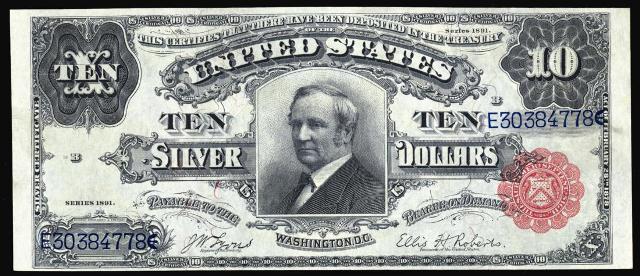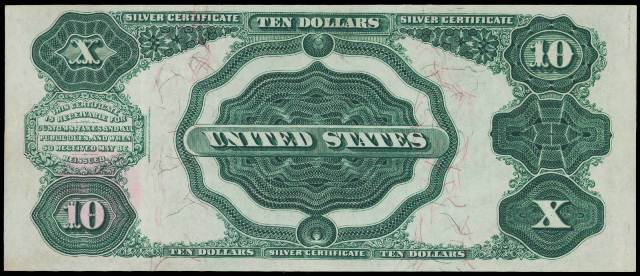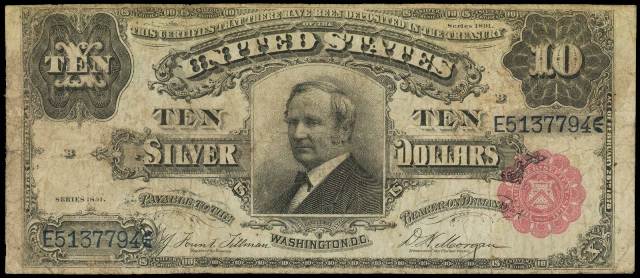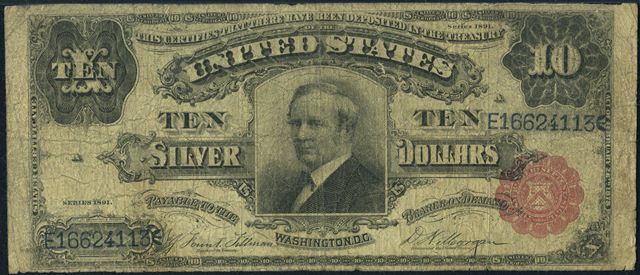Series of 1891 $10 Silver Certificate – Tombstone
History: The 1891 ten dollar silver certificate was issued from 1891 until 1907. The basic design type was used for the series of 1886 and the series of 1908. We are specifically looking at the series of 1891. If you have an example from 1908 then you can add about 20% to our listed values below. Or if you are lucky enough to have an example from 1886 then you can double the values we have listed. 1886 $10 silver certificates are much rarer.
Nickname: The 1891 $10 bill has one of the greatest nicknames in the hobby. Collectors call this a tombstone note. The portrait of Hendricks appears like it is featured on a tombstone. Just remember that when you are using collector lingo for this issue that you still need to specify whether you have an example from 1886, 1891, or 1908 – as all of those $10 silver certificates incorporated the same tombstone design.
Other Facts: The tombstone design may not be an accident by the Bureau of Engraving and Printing. Thomas Hendricks (the man in the portrait) died just a few months before his image was used on 1886 $10 silver certificates. So the tombstone style may have been an acknowledgement to his recent passing. Hendricks was the acting vice-president of The United States when he died in office.
Values and Grading: The 1891 $10 silver certificate is not an especially rare issue. However, it is not something that every dealer or coin shop is going to consistently have in stock. These notes are usually found in most semi-advanced collections. Values are based purely on condition. No star notes were printed for the series of 1891 (but there are some 1908 tombstone star notes known to exist). There are four different signature combinations for the 1891 $10 bill. Yours will either be signed by Rosecrans and Nebeker, Tillman and Morgan, Bruce and Roberts, or Lyons and Roberts. There is no premium for one signature combination over another. Each note has a red seal and blue serial numbers. Our guide below shows you some of the need to know information about how to grade and value these bank notes.
Choice Uncirculated or Better: Prices for 1891 $10 silver certificates in perfect condition range from $2,000 to $4,000, or even a little higher, based on factors like centering, color, and paper quality. There are some runs of consecutively numbered 1891 $10 bills out there. However, this is definitely not a “hoard” note like some other type notes from this time period. It takes time and a checkbook if you want one of these in a grade higher than about uncirculated. Grading companies are getting very strict with what is and isn’t UNC. The supply of high grade notes like this is certainly not increasing very much at all.

The Serial Numbers And Seal Really Pop On This 1891 $10 Silver Certificate
Extremely Fine to About Uncirculated: 1891 $10 silver certificates in XF and AU condition are definitely not plentiful. Prices range from $1,000 to $2,000. We have the back (or reverse) of an 1891 $10 bill pictured here. This is a great chance to show you what a washed and pressed note looks like. The red and blue fibers are especially obvious here. They have become prominent because they have expanded and bled through the paper because it got wet in the cleaning process. The red seal is also showing color on the back. It should not do that. Greedy dealers and collectors will sometimes “process” a note in the XF or AU grade in an attempt to remove the folds. Most collectors would prefer a fresh looking note with two folds rather than a washed out and flat note with no folds.

This 1891 $10 Bill Has Been Washed And Pressed, Thus Lowering The Value
Fine to Very Fine: It is pretty easy to purchase 1891 $10 silver certificates in nice looking circulated grades. Most collectors have no problem settling for something in the Fine 12 to Very Fine 35 range. The note we have pictured graded a 15 out of 70. It is very representative of what something on the lower end of this grade spectrum should look like. The colors are still vibrant but the paper is a bit soiled from changing hands many times. It has been folded so many times that you can’t even really count the folds any more. Higher grade very fine notes have paper that is strong enough to show folds. Prices for 1891 $10 bills in fine to very fine condition range from about $300 to $800.

This Is A Very Nice Looking Circulated 1891 $10 Silver Certificate
Very Good and Lower: The 1891 $10 tombstone we have pictured graded as an 8 out of 70. It is fully intact. You can see a couple of little margin nicks. The paper is dirty and soft. Most of the engraving details are not as clear as they would be on higher grade examples. When you start dealing with low grades like this it is normal to expect to see tears, margin damage, tape, stains, discoloration, and other problems that can significantly lower the value and eye appeal of a bank note. Most 1891 $10 bills in this grade range sell for between $50 and $150.

This 1891 $10 Bill May Look Ugly, But They Can Come Much Worse
Need an Appraisal or Offer? We provide free appraisals and we also buy 1891 $10 silver certificates. Just send us scans or digital photos of your bank note if you would like more information. We will respond quickly with an offer. Sales@AntiqueMoney.com


